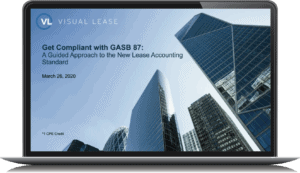Lease accounting (ASC 842, IFRS 16 or GASB 87) is not your average one-and-done disclosure. This whole new approach to accounting requires you to account for lease changes throughout the year with a higher level of scrutiny.
A daunting process for many healthcare organizations, lease accounting is a large project that demands cross-functional effort. But with the right preparation, it doesn’t have to be intimidating.
In this blog, we share an excerpt from a recent presentation featuring two major healthcare organizations, Penn State Health and Montefiore Health System, where they share how they transitioned to ASC 842 and maintained lease accounting compliance throughout the year.
Featured Speakers:

Joe Fitzgerald, Visual Lease:
Leases are inherently cross functional. There are many stakeholders involved with leasing, each with their own processes, systems and silos – (such as brokers, procurement, legal operations, accounting, tax, IT, you name it).
You need to make sure you’re maintaining an accurate audit trail and implementing guardrails so the changes being made by everybody are by the book.
What are some of Penn State Health’s considerations regarding cross–functional changes that affect accounting?
James Rogers, Penn State Health:
A lot of times, we found it’s believed that [lease accounting] is just a finance function. But finance relies heavily on supply chain, real estate and other departments when identifying leases.
To successfully work cross-functionally, we’ve set in place processes and policies, including ongoing communication between the real estate lease coordinators and finance – built around our Visual Lease solution.
You really have to take some time determining those policies and procedures because the process flow or the workflow will inevitably change with this new guidance, and you will as a finance department be leaning on this to help you stay compliant.
Joe Fitzgerald:
Two words come to mind, they both start with C – cooperation and collaboration. How about at Montefiore?
Fred Berardinone, Montefiore Health System:
Exactly, very similar to James. The importance of us leveraging automated lease accounting software was to have a centralized lease management system that we can build workflows according to our policies.
Similar to James, it’s all really finance’s domain, we would say liaison in this. But once again, this goes back to all the parties involved.
It’s really building the automation from the front end, from the data abstraction to Visual Lease or whatever software that whoever goes with, and into the general ledger and into accounts payable, and it’s all really getting blessed through least admin and finance.
So just as James mentioned, it’s really building that workflow, building those policies and procedures, and we still go back and test them, we’ll go back. We had internal audit actually take a look at our policies too, just verify that that’s how the system was working.
Joe Fitzgerald:
It sounds like what you both did at the start of the project in terms of working with the other folks has really paid off as you move forward in terms of cooperation and collaboration, that’s great.
To hear more about how Penn State Health and Montefiore Health System successfully use software to get and maintain audit-ready with lease accounting requirements, check out the full panel session here.
























